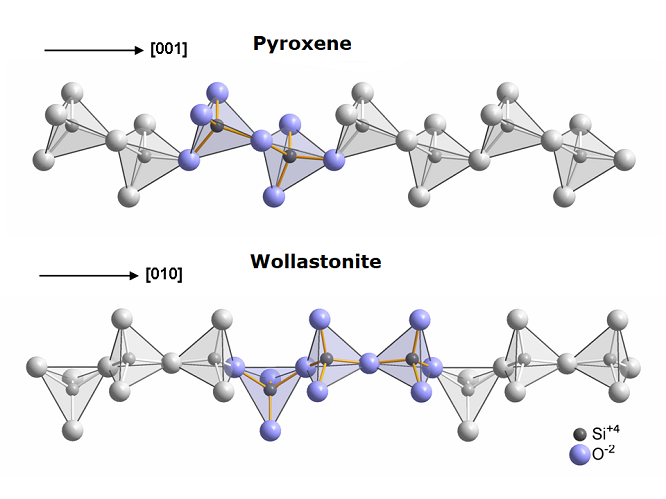Wollastonite - CaSiO3
Named in 1818 by J. Léman in honor of William Hyde Wollaston Norfolk, English chemist and mineralogist who discovered palladium (1804) and rhodium (1809) and invented the reflecting goniometer (1809). Wollastonite is a calcium inosilicate mineral. It forms when impure limestone or dolostone is subjected to high temperature and pressure sometimes in the presence of silica-bearing fluids as in skarns or contact metamorphic rocks. Associated minerals include garnets, vesuvianite, diopside, tremolite, epidote, plagioclase feldspar, pyroxene and calcite.Although it is a single-chain silicate, wollastonite is not a pyroxene. Wollastonite have a different type of infinite-chain structure, with three tetrahedra per unit cell arranged parallel to y (Fig.1), this repeat unit consisting of a pair of tetrahedra joined apex-to-apex as in the [Si2O7] group, alternating with a single tetrahedron with one edge parallel to the chain direction.

Fig.1: Tetrahedra arrangement within the chains in pyroxenes compared to wollastonite. From Wikipedia.
Wollastonite is a common mineral in contact metamorphosed calcareous limestones, where the Si is metasomatically introduced, and also in the invading igneous rocks as the result of contamination. In most of these occurrences it is the result of the reaction:CaCO3 (calcite) + SiO2 (quartz) = CaSiO3 (wollastonite) + CO2.
In the progressive metamorphism of siliceous dolomites, the early stages of the sequence are talc-tremolite-diopside-forsterite-wollastonite-periclase-monticellite, and the formation of wollastonite normally approximating to the highest grade of contact metamorphism against a granite. Wollastonite may occur in regionally metamorphosed rocks of appropriate composition.
Optical Properties:
• Form: Columnar, bladed or fibrous.
• Color: Colorless.
• Relief: Moderate.
• Birefringence: Up to I order Red.
Bibliography
• Bucher, K., & Grapes, R. (2011). Petrogenesis of metamorphic rocks. Springer Science & Business Media.
• Fossen, H. (2016). Structural geology. Cambridge University Press.
• Howie, R. A., Zussman, J., & Deer, W. (1992). An introduction to the rock-forming minerals (p. 696). Longman.
• Passchier, Cees W., Trouw, Rudolph A. J: Microtectonics (2005).
• Philpotts, A., & Ague, J. (2009). Principles of igneous and metamorphic petrology. Cambridge University Press.
• Shelley, D. (1993). Igneous and metamorphic rocks under the microscope: classification, textures, microstructures and mineral preferred-orientations.
• Vernon, R. H. & Clarke, G. L. (2008): Principles of Metamorphic Petrology. Cambridge University Press.
• Vernon, R. H. (2018). A practical guide to rock microstructure. Cambridge university press.


.jpg)
.jpg)
.jpg)
.jpg)
.jpg)
.jpg)
.jpg)
.jpg)
.jpg)